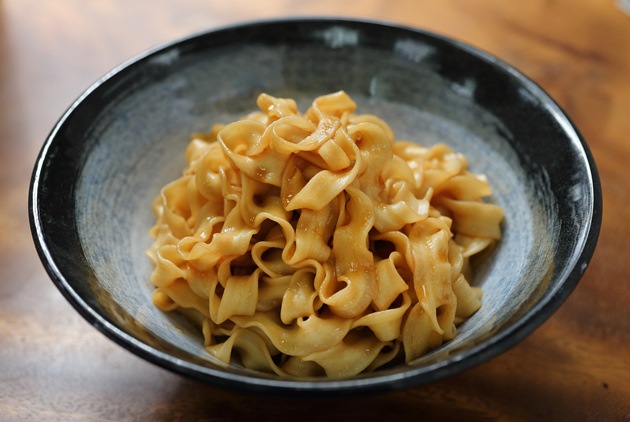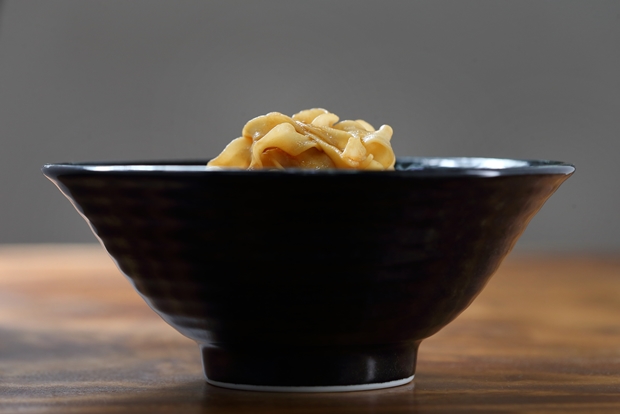Taiwanese Sun-Dried Noodles
How Tseng Noodles Made It into The Ramen Rater's Top Ten

Source:Chiendong Wang
It would take up to three months of waiting to have a slurp of these chewy scallop-edged wide noodles coated completely with Sichuan Pepper sauce. What is it about these noodles that could win the taste bud of "The Godfather of Ramen"? What is the story behind its success?
Views
How Tseng Noodles Made It into The Ramen Rater's Top Ten
By Mingling Hsiehweb only
The Tseng Noodles (曾拌麵 or Zeng Noodles) have blown a whirlwind over the past two years, sweeping both web and brick-and-mortar channels around the world.
Two years ago, during its pinnacle, it would take an average of three months for one to get one pack of these dried noodles, which costs three to four times the normal price of other packaged noodle brands. Today, the noodles have found its way to Costco, Jason’s Market, and Shin Kong Mitsukoshi, expanding its market to the United States, Canada, Hong Kong, Macau, the Philippines, and Malaysia, though it still takes a customer in Taiwan a week to half a month to get one pack.
Many have been asking why the manufacturer of the noodles has shown no intentions of outsourcing, or enlarging their scale of production to keep customers from waiting.
“My colleagues have been asking the same question. ‘The money is at our doorway. Why not sweep it in?’ In fact, the easier the money comes, the more important it gets for us to persist. We can’t just pick up a few more product lines. Making noodles is not that simple,” said Chingfen Peng (彭靜芬), Vice Manager at Shih Wei Hsien (食味鮮) Food Corp. Though being accused of using “hunger marketing”strategies, they pressed on their unwillingness to rush into thoughtless outsourcing to fill the market’s need.
Tseng Noodles—How Did They Stand Out from the ‘Red Sea’ of Competitors?
According to Yuling Chen, researcher at the Food Industry Research and Development Institute, the outbreak of the cooking oil scandals in 2013 and 2014 has raised concerns over the oil sachets that come with each instant noodle package. Customers have thus turned to either imported instant noodles, or “dried noodles.” In addition, it was never easy for new suppliers to break into the market occupied by major traditional brands of instant noodles. Instead of seeking outsourcing partners, many chose to start their business in “dried noodles.”
Over the past few years, “dried noodles” like Tseng Noodles have become a staple of the market. From older brands such as A Sha Dry Noodles (阿舍乾麵), SRH Noodles (雙人徐), Wu-Mu Ramen (五木), to arising brands like Jhen Mien Tang (真麵堂), Tseng Noodles, and Lan Shan Noodles (蘭山麵), competition has been fierce.
The Birth of Tseng Noodles
In 2001, Chingfen Peng along with her two partners started a business in “spicy crabs” with their recipe inspired by a trip to Shanghai. The restaurant attracted Sam Tseng (曾國城), who was then a host of a cooking show, to come for a visit and later become an investor. In the heyday of Shi Wei Hsien Spicy Crabs, one single branch in Zhubei, Hsinchu could have taken up nearly 700 m2 of space (almost half the size of a baseball field), be booked up each day for each meal, and have their workers work up to 16 hours each day. “The street would get clogged up around 16:30, for those from the Hsinchu Science Park will be taking their clients out for dinner,” said Peng.

This company made up by four quickly expanded their business to Western style restaurants, Japanese pubs and so on. Yet shockingly, struck by the Financial Storm, Spicy Crabs’ revenue shrunk from NT$4 million to NT$0.9 million, an amount that cannot make up the loss from their other extended businesses. They became NT$20-30 million in debt, not including loans made outside of Zhubei.
To deal with their debt, they closed their stores, one by one, woke up around four or five in the morning each day to make bentos (lunch boxes) for television broadcasting stations, and followed their friends’ suggestion by starting to sell frozen mutton hot pot combos and ginger duck stew.
Years of struggles passed. They were not yet clear of debt. Then it suddenly occurred to them: Since the whole company were noodle-lovers, why not develop their own brand of noodles? For the next eight months, they devoted themselves into constant research on how the thickness, the width, and the sauce of the noodles would affect the taste of noodles, and how to ensure quality from outsourced manufacturing. Finally, the Tseng Noodles were born. “That was a time when we nearly got fed up with noodles, literally, for each and every meal,” recalled Peng, who was at the time in charge of the research.
So what are the reasons for their overnight success?
Reason #1. Irreplaceable Taste
First of all, this product leaves a haunting impression. Their most popular flavor—Tseng Noodles Scallion With Sichuan Pepper—features the spicy sauce they invented for the Spicy Crabs, which well-balances the scallop-edged wide noodles that were spun into differing thickness. Its appealing richness in texture and taste leaves even the pickiest taste buds impressed.
According to Peng, the devil lies in the quality of the shaping process of the noodles. Since the differing thickness can make the noodles get easily overcooked on the ends and edges, design improvement and quality control play a crucial role.

It’s not only the R&D process that is effort and time-consuming, but also the quality control and improvement in manufacturing. For the noodles, they claim that they use nothing more than flour, water, and salt to make the dough that would then undergo eight to ten sets of kneading procedures and be turned into blocks of noodles that get sun-dried and packaged in the “Sunshine House.”
During this process, the design and ventilation of the “Sunshine House” determines whether the noodles would become over-dried and fragile, or go over-wet and moldy. This takes constant collaborative efforts with the outsourcers and regular sampling. Once, the thin noodles of the Hu Sesame flavor became too fragile, and they returned all the products back for disposal without hesitation.
Reason #2. An American Blogger+ Taiwanese Celebrity
The second key lies in successful Internet marketing.
According to Chingpeng Su, Chief Manager of Tseng Noodles’ marketing partner Han Tai Taiwan (韓太公司), their marketing strategy started from promotional videos starring Sam Tseng. Gradually, the noodles began to gain traction with the help of other well-known celebrities who took the initiative to share their reviews. Yet what really triggered overnight success for them was the idea of offering the noodles as a gift to an American critic blogger, Hans Lienesch, also known as “The Godfather of Ramen,” who later ranked the noodles ninth place in The Ramen Rater’s Top Ten Instant Noodles of All Time.
According to the observation of MoMo, an online payment platform where the Tseng Noodles hit sales of NT$1 million every month, the noodles first became a hot topic on the Internet thanks to reviews from bloggers and Sam Tseng’s high popularity for hosting cooking shows. Recommendations from celebrities have made the brand familiar to the public, but what really pushed them into a buying frenzy was the widespread curiosity over the taste that had won the heart of the “Godfather of Ramen.”
The brand’s phenomenal success was a surprise to even its creators, admitted Peng. With zero experience in sales management, they learned everything as a beginner from managing outsourcers, contract signing with brick-and-mortar channels, and price negotiating with export agencies.
Taking “Pami” to the Global Stage
In late July 2017, Sam Tseng initiated a press conference two years after the release of the product, announcing their upcoming new store in Dadaocheng (大稻埕), and the new name for the brand—“Pami” (Sun-dried noodles, or Guanmiao Noodles in Taiwanese). Their goal is to turn this made-in-Taiwan “Pami” into a generic term like Japanese Ramen and Italian Pasta.
“Anyone can pronounce ‘Pami.’ We want it to become the new word for Guanmiao noodles,” said Peng. Their next move would be promoting plain noodles in the name of “Pami” to the global market, inviting buyers to create their own “Pami” recipe.
From success to debt, and finally to new prosperity, the journey of Shih Wei Hsien has not yet come to an end. Their next challenge would be to optimize their place in this market full of competitors, to make their overnight fame last, and to weave a new future for Taiwanese noodles.
As Peng recalled her two-decade journey of starting a business, she said emotionally: “We are no strangers to failure. But that’s what made us even more grateful for the wings God gave us to soar high again.”
Translated by Sharon Tseng
Additional Reading
♦ The Secret Relation Between An Arabian Dish and Taiwan's
♦ Japanese Restaurant Invasion: Taiwan's the First Stop
♦ Taiwan Tea in Starbucks







